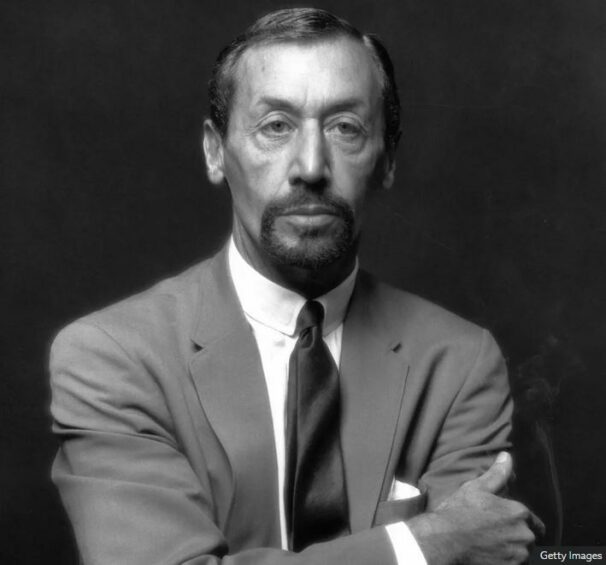
was so bad-assed you’d think people would show respect. Instead, one of American-dance’s most original creators was stolen from, even in his lifetime–and he knew it.
Nineteen million people watched, on Sunday night, when, at the 96th Oscar Award ceremony, actor Ryan Gosling, looking hot in hot pink (“Barbie pink,” as it has come to be known), sashayed onto the stage of the Dolby Theater, mike in hand, and charmed the room in a rousing round of Oscar-nominated song, “I’m Just Ken.”
Then he danced. Kind of. He moved with grace and confidence, waving his pink-gloved hand as he fit in among a gang of guys who slithered in sleek hip-hop unison stepping. The energy was high and while it was a bit of a mess to view via camera, the reaction in the Dolby audience left no doubt that, in person, the effect was electric.
Gosling’s “I’m Just Ken” was uniformly called the runaway hit of the Oscars broadcast (The New York Times next-day headline: “How ‘I’m Just Ken’ Won the Oscars Without Winning an Actual Oscar”). Perspicacious viewers noted, in real time, that the number rested on several judiciously borrowed motifs and memes from Jack Cole‘s “Diamonds Are A Girl’s Best Friend,” itself the jewel in the crown of Gentlemen Prefer Blondes (1953). It also borrowed from Busby Berkeley in its use of an overhead shot with dancers scurrying around holding face masks of Barbie — quoting from “I Only Have Eyes for You” Berkeley’s number in Dames (1934) featuring the many heads of Ruby Keeler in Berkeleyesque patterns.
But back to “Diamonds.” Because that’s the problem. The name Busby Berkeley falls trippingly off tongues. Jack Cole’s does not.
The first giveaway was the staging of “I’m Just Ken” on a cropped pink staircase, as did Cole, using red, for “Diamonds.” Cole often used structures like staircases in his film choreography (others: ladders, ramps, boxes, even sliding boards) in order to exploit every inch of the film frame’s real estate.
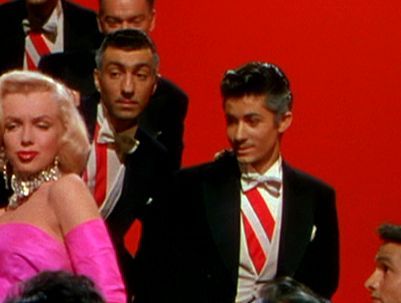
“I’m Just Ken”‘s male dancers, like Cole’s in “Gentlemen,” wear red sashes as “Ambassadors.” The fact that the tuxedo-clad men surrounding Marilyn Monroe (there, I’ve said her name) are playing ambassadors was relayed to me by George Chakiris, who was one of them.
“Ken” also borrowed from Cole’s anthropomorphic human candelabrae which in turn Cole may have borrowed from Jean Cocteau’s hand-held ones in Beauty and the Beast (1946). This was not in my line of vision (the number was frenetic) but Mandy Moore who staged it said in interviews that her dancers held candles, calling themselves “Ken-delabras.” The men up hold red punch boards to Gosling, aping how Cole’s dancers held up red Valentine hearts to Monroe.


Cole would never choreograph something so “on the nose” as illustrating the song lyric, “A kiss on the hand may be quite continental …” but Gosling & Moore did. So be it. It was fun when Gosling puckered up and smooched the hand of the Steadicam operator, who turned out to be a man. People in the room knew that; we at home did not. Again, clever.
And on it went. People loved it. Steven Spielberg was seen in the audience broadly smiling with delight. It’s all good. In my capacity as biographer of Jack Cole, in a book still in-process, I’m unsurprised that “Diamonds Are A Girl’s Best Friend” continues to hold such appeal. There have been multiple borrowings from it over the years, famously by Kenny Ortega’s “Material Girl” for Madonna, which also did nothing to credit Jack Cole. I so fervently wish that Cole’s name zinged through popular culture with as much vibrancy as his enduring creativity.
It was crushing, deeply disappointing, to read, first, in her interview in Variety and then, in the New York Times, that choreographer Mandy Moore did not loudly and proudly trumpet the name of Jack Cole.
Here she is quoted in the New York Times:
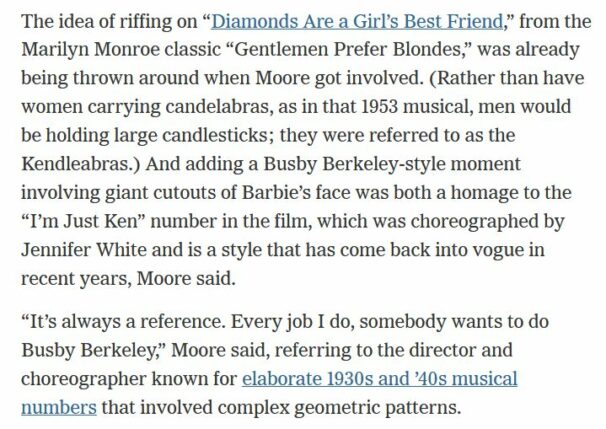
Here she is in Variety:
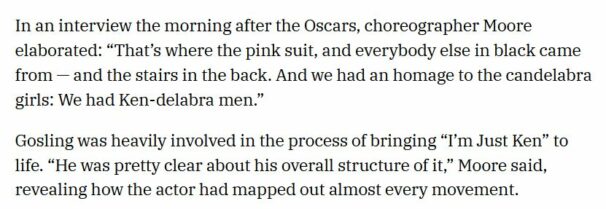
Here Moore speaks to The Hollywood Reporter.
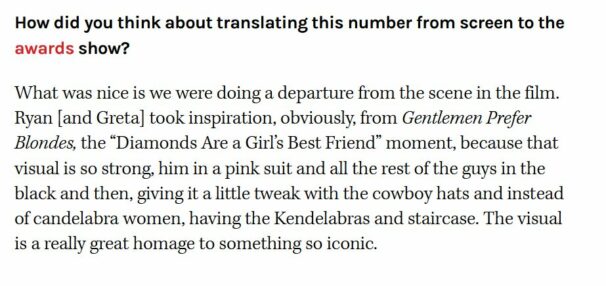
Jack Cole’s “Diamonds” was a “take-two” that he had to come up with under considerable duress — his first, and preferred, version was deemed too sexual and was censored, leaving Cole facing a blank slate. Every element of “Diamonds Are A Girl’s Best Friend” stemmed from Cole’s febrile imagination: the color scheme, the costumes, the beautifully spare, perfectly rehearsed dance steps for the corps de ballet, the dramaturgy, the brilliant use of space (see Mandy Moore’s version for contrast), and famously, Monroe’s performance assiduously coached and rehearsed by Cole and Gwen Verdon.
Dance makers of Hollywood are seeking recognition for their craft by pressing the Motion Picture Academy to add an Oscar for Best Choreography. That is understandable. But they must first recognize their own. Go ahead, use Cole’s vivid ingenuity in “Diamonds.” Quote from it, bend and shape it, twist it and turn it, have a ball. You can even call it a “Marilyn Monroe dance number,” although that’s not an accurate description. But if you piggy-back on the creation of Jack Cole . . . at least say his name.
Debra Levine is a longtime Los Angeles-based dance critic and the author of an upcoming biography of Jack Cole.
Author wishes to thank Jeffrey Spivak, author of Buzz: the Life and Art of Busby Berkeley, for information.

It infuriates me that they stole this. If it was the other way around – ha! Awful. No wonder I stopped watching the award shows
Excellent article Debra ! Vraiment vraiment excellent !!
My two cents: Thanks for standing up for Cole and other choreographers who deserve credit for their work! Would you consider Hermes Pan in terms of the masks…think “Shall We Dance/ Finale and Coda” and not just Busby Berkeley who is referenced via the overhead shot? Maybe an interview with Moore would be on the agenda?
Also as an aside, I know that choreographers have worked in animation (George Balanchine in Fantasia’s Dance of the Hours though according to Anel Muller not a formal involvement but as inspiration [?] “Specifically it would be the Water Nymph ballet choreography he created in 1938 for the film Goldwyn Follies that would serve as inspiration for Fantasia’s seventh segment: “Dance of the Hours”.) but I never see any credit for their work in this medium either. I see, for example, Jerry (Tom and Jerry cartoons) executing entre chat quatre or a pirouette but cannot find the ‘inspiration credit’ for these moves.
“a direct quote of how Berkeley converted a horde of chorus girls with Ginger Rogers masks in Shall We Dance (1937).”
Busby Berkeley did not work on “Shall We Dance”. He did, however, direct “Dames” and the musical number “I Only Have Eyes for You” featuring the many heads of Ruby Keeler in Berkeleyesque patterns.
Jeffrey Spivak, author “Buzz: The Life and Art of Busby Berkeley”
I love Cole’s work in “Diamonds” — it is indeed as clear as the stones from the title. But I thought that Moore did a great job with her double focus assignment. While many more people see the work on television, it’s still got an audience in the theater, and needs to be coherent for them as well. And my family got the steadicam hand kiss reference right away.
It was heartening to see the NYT advocating for better screen credit for choreographers and recognition when it comes to the awards world. We still have a long way to go, however. The popular culture newsletter from the Washington Post did mention Moore as the choreographer for the awards telecast, but they went out of their way to say that she was “not that Mandy Moore.” (to be fair, they were very charming when I pointed out that for some of us, the choreographer is indeed “the” Mandy Moore.)
I credit everyone in my book, Debra. Assistants, dancers, as many people as I can. So important.
Even I, an aging acrobat and painter, know and revere the riveting aesthetics and ingenious grace of group movements that Cole excelled in. This was such a brilliant and vital – so vital – expose of truths and history unlearned. Legends of the physical arts are well documented and scored, carried forward on the shoulders, let alone in the hearts of the next generation. Shame on Moore. She was certainly and decidedly LESS in terms of respect and acknowledging her sources. Perhaps she was truly ignorant, and didn’t know, unlikely, given her experience.
Thank you for posting this great and balancing article.
Wonderful comment, Ezrha Jean, and great to hear from you.
“Wench”!!
Yes, credit the legacy. I agree.
Debra
Thank you for your comment, Vince. I just attended your book talk, for your recent memoir, Icons and Instincts. At the talk you told the story (it’s in the book as well) of how, in choreographing MJ in “Smooth Criminal,” you drew from an effect you saw in a dance concert by MOMIX, in which the dancers were leaning precipitously, and you adopted that lean for Michael. All these years later, you are still crediting from whence that idea. It’s as easy as that, and there’s simply no excuse to not do so — especially with a dance GIANT like Jack Cole.
Agreed. Sadly, many younger dancers/choreographers have no dance history training. They know Fosse but not Jack Cole. Sad!
As we say more often in the political sphere — ‘HOLD THEM TO ACCOUNT!’ Thank you for this excellent and ESSENTIAL follow-up and corrective to the first post-Acad.Awards critiques & assessments on this dazzling number that all but stole the entire show. Moore absolutely should have given Cole credit for his original concept which is clearly (FAR beyond Busby Berkeley) the template for her choreography. No problem with the ‘steal’ — geniuses do it all the time — but puh-LEEZE credit the legacy. Demerits to the wench who stole from Jack Cole.